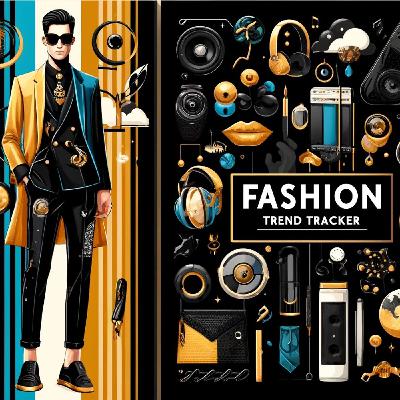Navigating Fashion's Transformation: Circularity, AI, and Strategic Collaborations in 2025
Update: 2025-10-01
Description
Based on the available information, here is a current state analysis of the fashion industry:
The fashion industry is experiencing significant transformation as we move through late 2025, driven by regulatory pressures, supply chain adaptations, and strategic collaborations reshaping the competitive landscape.
The most critical development is the impending EU ban on destroying unsold clothing and footwear, taking effect for large enterprises in July 2026. This regulation forces brands to abandon the traditional linear take-make-dispose model and implement circular strategies including donation, repair, and recycling for excess inventory. California's Responsible Textile Recovery Act reinforces this trend, holding producers accountable for their products' entire lifecycle. These Extended Producer Responsibility schemes fundamentally alter cost structures, as brands must now pay for garment disposal, encouraging design for durability and recyclability.
Supply chain disruption remains a defining challenge. Asia-to-US shipping costs spiked 165 percent from December 2023 to February 2024, while tariffs have increased fivefold since 2015. US apparel imports from China dropped six percentage points between 2019 and 2023, accelerating diversification to Vietnam, India, Bangladesh, and nearshoring to Mexico, Turkey, and North Africa. Companies are prioritizing supply chain agility through multiple sourcing options rather than single-source dependencies.
Artificial intelligence is transforming consumer engagement and operational efficiency. Research shows 82 percent of consumers want AI to reduce shopping research time, while 50 percent of fashion executives prioritize AI-driven discovery. Companies are focusing on hyper-personalization, with 84 percent of organizations prioritizing personalized customer touchpoints.
Strategic collaborations are defining 2025's competitive landscape. Notable partnerships include Palace Skateboards with Maharishi, Pharrell Williams and Nigo with Louis Vuitton, Balenciaga with PUMA, and H&M with Glenn Martens. These collaborations bridge luxury and streetwear, democratizing high fashion for broader audiences.
Gap's Fall/Winter 2025 campaign featuring Gwyneth Paltrow and Apple Martin exemplifies brands leveraging multigenerational marketing to connect with diverse consumer segments. The 38-piece capsule blends architectural elements with cultural references, targeting both established and emerging demographics.
Current conditions reflect an industry balancing regulatory compliance, operational resilience, and creative innovation while adapting to evolving consumer expectations and geopolitical pressures.
For great deals today, check out https://amzn.to/44ci4hQ
This content was created in partnership and with the help of Artificial Intelligence AI
The fashion industry is experiencing significant transformation as we move through late 2025, driven by regulatory pressures, supply chain adaptations, and strategic collaborations reshaping the competitive landscape.
The most critical development is the impending EU ban on destroying unsold clothing and footwear, taking effect for large enterprises in July 2026. This regulation forces brands to abandon the traditional linear take-make-dispose model and implement circular strategies including donation, repair, and recycling for excess inventory. California's Responsible Textile Recovery Act reinforces this trend, holding producers accountable for their products' entire lifecycle. These Extended Producer Responsibility schemes fundamentally alter cost structures, as brands must now pay for garment disposal, encouraging design for durability and recyclability.
Supply chain disruption remains a defining challenge. Asia-to-US shipping costs spiked 165 percent from December 2023 to February 2024, while tariffs have increased fivefold since 2015. US apparel imports from China dropped six percentage points between 2019 and 2023, accelerating diversification to Vietnam, India, Bangladesh, and nearshoring to Mexico, Turkey, and North Africa. Companies are prioritizing supply chain agility through multiple sourcing options rather than single-source dependencies.
Artificial intelligence is transforming consumer engagement and operational efficiency. Research shows 82 percent of consumers want AI to reduce shopping research time, while 50 percent of fashion executives prioritize AI-driven discovery. Companies are focusing on hyper-personalization, with 84 percent of organizations prioritizing personalized customer touchpoints.
Strategic collaborations are defining 2025's competitive landscape. Notable partnerships include Palace Skateboards with Maharishi, Pharrell Williams and Nigo with Louis Vuitton, Balenciaga with PUMA, and H&M with Glenn Martens. These collaborations bridge luxury and streetwear, democratizing high fashion for broader audiences.
Gap's Fall/Winter 2025 campaign featuring Gwyneth Paltrow and Apple Martin exemplifies brands leveraging multigenerational marketing to connect with diverse consumer segments. The 38-piece capsule blends architectural elements with cultural references, targeting both established and emerging demographics.
Current conditions reflect an industry balancing regulatory compliance, operational resilience, and creative innovation while adapting to evolving consumer expectations and geopolitical pressures.
For great deals today, check out https://amzn.to/44ci4hQ
This content was created in partnership and with the help of Artificial Intelligence AI
Comments
In Channel





